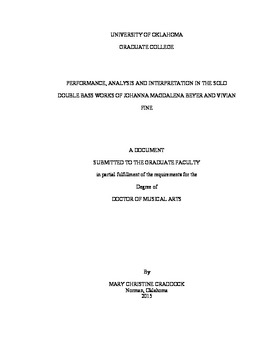| dc.description.abstract | Though musical works worthy of study and performance, Johanna Magdalena Beyer’s 1936 Movement for Double Bass and Piano and Vivian Fine’s 1964 Melos for solo double bass have been neglected by both performers and scholars. Research on these composers by Beal, Cody, Kennedy and Polanksy, and Von Gunden briefly mentions these pieces, but primarily in the context of complete works lists or short superficial descriptions. These works have been performed and recorded a handful of times over the years, most notably by bassists Black, Kohn and Synot, but an in-depth discussion of these pieces by double bassists themselves remains to be done. This document will expand practical and academic inquiry into these worthy but overlooked works by examining the surrounding contexts and content of each from the perspective of performance studies. By focusing theoretical and practical analysis around performance, this document will provide a thorough discussion of both pieces from a useful and unusual perspective. It will demonstrate that these works enrich the solo double bass repertoire by making unique aspects of the double bass cornerstones of the work. In the case of Beyer’s Movement, this cornerstone is the bass’s range; in the case of Fine’s Melos, it is the possibilities of register. The discussion of Movement will consider Beyer’s biographical circumstances at the time of its composition, how this relates to an exploration of range on the double bass, and the determinative influence of range on structure and melody. In Melos, the influence of double bassist Bertram Turetzky on technical and stylistic aspects of the work lead to a reading of the piece in terms of register and the left hand. Three distinct layers of register operate in Melos that play a decisive role in structure and melodic construction. Examining these works by focusing specifically on range and register will reveal that both pieces expand the double bass’s solo repertoire into a new aesthetic space that highlights the bass’s distinctive and idiosyncratic qualities. | en_US |
